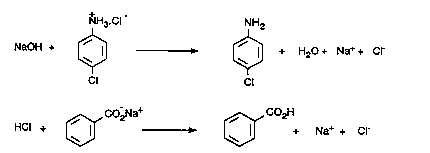
| McMaster University - Chem2O06 Lab Manual | 1997/98 |
Expt. 1, Part A. Separation of 4-Chloroaniline, Benzoic acid, and 4-Dibromobenzene.
Introduction. Separation of a Mixture
The separation of a mixture of chemical compounds A and B into its separate constituents is achieved by methods which depend on a difference in either the physical or chemical properties of A and B. If A and B differ in their physical properties then they may usually be separated by virtue of their different solubilities in a pair of immiscible solvents. An example of such a mixture would be sodium chloride and cholesterol, both of which are white, crystalline solids. The separation here would be quite simple. Sodium chloride, an ionic salt, is soluble in water but insoluble in ether whereas cholesterol, a neutral organic molecule, is soluble in ether and only very sparingly soluble in water. Shaking the mixture with a mixture of water and ether would result in the formation of two immiscible solutions, one of sodium chloride in water and one of cholesterol in ether. Separation of the two solutions in a separatory funnel and the evaporation of each solution separately would then lead to the recovery of individual samples of both sodium chloride and cholesterol.
In a more complex case, such as the separation of sodium chloride from 3-aminobenzoic acid where one component (in this case the 3-aminobenzoic acid) is soluble in both water and ether, a process known as extraction has to be used. There the mixture is dissolved in water and the resulting solution shaken with ether in a separatory funnel. The 3-aminobenzoic acid, being soluble in both the aqueous and ethereal layers, will partition itself between the two layers and this partitioning is described by the partition or distribution coefficient, Kp, as follows:
Kp = solubility in ether / solubility in water
The solubility of 3-aminobenzoic acid in water at 20oC is 6.0 gram/litre (g/L), while in ether it is 20.0 g/L. Therefore,
Kp = (20 g/L) / (6 g/L) = 3.33
Suppose that 2.0 g of 3-aminobenzoic acid is present in the mixture and that the compound is allowed to partition itself between l litre of water and l litre of ether at 20 oC. How much of the acid will be present in each layer?
If Z is allowed to represent the concentration in g/mL of acid in the water, then from the definition of the partition coefficient,
Kp = (concentration of acid in ether) / Z = 3.33,
Thus, (concentration of acid in ether) = 3.33 x Z
wt. of acid in 1 L of water = l000 x Z
wt. of acid in 1 L of ether = l000 x 3.33 x Z
But,
total wt. of acid = 2.0 g
Therefore,
(l000 x Z) + (3.33 x l000 x Z) = 2.0 g
i.e. 4330 x Z = 2.0 g
or Z = 2.0 / 4330 = 0.000462 g/L
Therefore,
wt. of acid in water = 1000 x Z = 0.462 g
and
wt. of acid in ether = 1000 x 3.33 x Z = 1.538 g
Thus, by a single extraction of 1000 mL of aqueous solution by 1000 mL of ether, 1.538 g of the original 2 g of acid present in the water will be transferred to the ether layer. It should now be evident that by removal of the first litre of ether and re-extraction of the aqueous layer with a fresh batch of ether, partitioning of the remaining 0.462 g of acid between the aqueous and the second ethereal layers will result in the transfer of a further 0.355 g of acid into the ether, leaving only 0.107 g in the aqueous layer. The repeated extraction of the aqueous layer with fresh batches of ether will lead therefore to the removal of most of the acid into the ether. The acid may then be recovered by evaporation of the combined ether extracts.
In many cases, mixtures of organic compounds can be separated by methods which depend on a difference in their chemical properties. Frequently, one or more compounds of a mixture is transformed into a salt for easy separation. Salts, in general, are water soluble and insoluble in organic solvents. For example, for acidic compounds (HA):
For bases (B:):
In this experiment, you will separate a mixture of 4-chloroaniline, benzoic acid and 4-dibromobenzene in order to illustrate this process. This mixture may be readily separated by virtue of the fact that whereas 4-chloroaniline will react with HCl in water, benzoic acid will react with sodium bicarbonate (NaHCO3) in water, and 4-dibromobenzene is simply insoluble in water. Thus, if a solution of a mixture of 4-dibromobenzene, 4-chloroaniline, and benzoic acid in ether is shaken with aqueous HCl the amine will be removed into the aqueous layer as its ammonium salt, whereas 4-dibromobenzene and benzoic acid will remain dissolved in the ether. The benzoic acid then can be extracted as its sodium salt by extracting the ether layer with aqueous NaHCO3.

After separation of the aqueous and etheral layers, the 4-chloroaniline can be regenerated by basification with aqueous NaOH, while benzoic acid can be regenerated from its sodium salt by acidification with dilute acid.

| Go to: | Instructions for Printing this Document Experiment 1 Part A Procedures Chem2O06 Home Page. |
04sep97; wjl